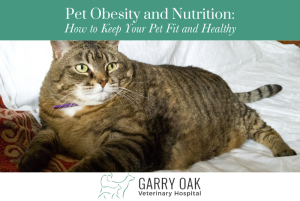 Understanding Obesity in Pets
Understanding Obesity in Pets
Obesity in pets is an increasingly common health concern. According to recent studies, approximately 60% of dogs and cats are considered overweight or obese, which can lead to serious health complications. Pets, like humans, can develop obesity from overfeeding, a lack of exercise, or underlying health issues. At Garry Oak Veterinary Hospital, we are committed to helping pet owners maintain their pet’s ideal weight, contributing to their quality of life and longevity.
Why is Pet Obesity a Concern?
When pets carry extra weight, it places additional stress on their bodies, especially their bones, joints, and internal organs. Obesity in pets can lead to various health issues, including:
- Diabetes Mellitus: Pets who are overweight are at a higher risk of developing diabetes, which requires lifelong management.
- Joint and Mobility Problems: Excess weight strains the joints, making conditions like arthritis more likely and harder to manage.
- Heart and Respiratory Issues: Obesity increases the workload on the heart and lungs as well as increases the risk of high blood pressure, potentially shortening a pet’s lifespan.
- Increased Cancer Risk: Some types of cancer are more prevalent in obese pets.
- Reduced Lifespan: On average, obesity can reduce a pet’s lifespan by up to two years.
Causes of Obesity in Pets
Understanding the causes of pet obesity can help you better manage your pet’s weight. The primary factors include:
- Overfeeding and Free-Feeding: Feeding pets whenever they seem hungry can lead to overconsumption of calories.
- Treats and Table Scraps: While treats are great for training, too many treats or high-calorie snacks can quickly add up.
- Lack of Exercise: Indoor pets or pets with restricted physical activity are at a higher risk of gaining weight.
- Age and Metabolism: Older pets and certain breeds have slower metabolisms, making them more prone to weight gain.
- Underlying Health Issues: Some pets may have hormonal imbalances or other medical issues that predispose them to weight gain for example hypothyroidism in dogs.
Nutrition Tips for Maintaining a Healthy Weight
Ensuring your pet gets the right balance of nutrients is key to keeping them healthy and preventing weight gain. Here are some essential tips:
- Choose High-Quality Pet Food: Look for a balanced diet with appropriate protein, fiber, and essential nutrients will support your pet’s overall health. If your pet is overweight, feeding a veterinary prescription weight loss food can result in effective weight loss.
- Portion Control: Measure your pet’s food according to their weight, age, and activity level. Avoid free-feeding unless advised by your veterinarian.
- Minimize Treats: Treats should make up no more than 10% of your pet’s daily caloric intake. Opt for low-calorie treats or offer fresh fruits and vegetables like carrots or green beans for dogs.
- Establish a Regular Feeding Schedule: Pets thrive with routine. Feeding them at the same time each day helps regulate their metabolism and prevents overeating.
- Encourage Physical Activity: Regular exercise is vital. Find an activity your pet enjoys, like fetch for dogs or interactive toys for cats, to keep them moving.
Monitoring Your Pet’s Weight and Health
To help ensure your pet maintains a healthy weight, consider these practices:
- Regular Weigh-Ins: Check your pet’s weight regularly, for example every month. For accuracy, we recommend using the scale at Garry Oak Veterinary Hospital where we can track weight changes over time
- Assessing Body Condition: Observe your pet’s body shape. A healthy pet should have a visible waist when viewed from above and an abdomen that is tucked up from the side view.
- Routine Vet Visits: Regular veterinary check-ups allow early detection of any health issues related to weight gain and ensure your pet is receiving the proper nutrition.
Q&A Section
Q: How can I tell if my pet is overweight?
A: Check for a visible waistline when viewing from above, and the abdomen should tuck up when viewed from the side. You should also be able to feel, but not see, their ribs. If in doubt, visit Garry Oak Veterinary Hospital for a weight assessment.
Q: What are some safe exercise options for pets with obesity?
A: For dogs, short and frequent walks are best to avoid straining joints. Swimming is also excellent for dogs with mobility issues. Cats can benefit from laser pointers, feather toys, or climbing trees for low-impact activity.
Q: Can my pet lose weight by changing their food?
A: There are veterinary prescription weight loss foods that are designed for weight loss that can effectively reduce weight safely in our overweight pets.
Q: How many treats are safe for my pet to have each day?
A: Treats should make up no more than 10% of your pet’s daily caloric intake. Always opt for low-calorie or healthy treat options, like carrots or apple slices for dogs.
Q: What health risks should I be aware of if my pet is obese?
A: Obese pets are more susceptible to diabetes, arthritis, heart disease, and some cancers. Additionally, they may have reduced energy levels and a shorter lifespan. Our team can help you reduce these risks with a comprehensive weight management plan.
Q: How often should I schedule check-ups to monitor my pet’s weight?
A: We may recommend pets on weight loss programs to come in more regularly than their yearly annual exam. More regular check-ins will allow us to adjust their diet and exercise plans as needed.
Contact Us
If you’re concerned about your pet’s weight or want guidance on proper nutrition, our team at Garry Oak Veterinary Hospital is here to help. We offer comprehensive weight management programs tailored to your pet’s unique needs, ensuring they lead a happy, healthy life.
Visit us at:
Garry Oak Veterinary Hospital
9837 Seventh St
Sidney, BC V8L 4B1
Phone: (250) 656-3955
